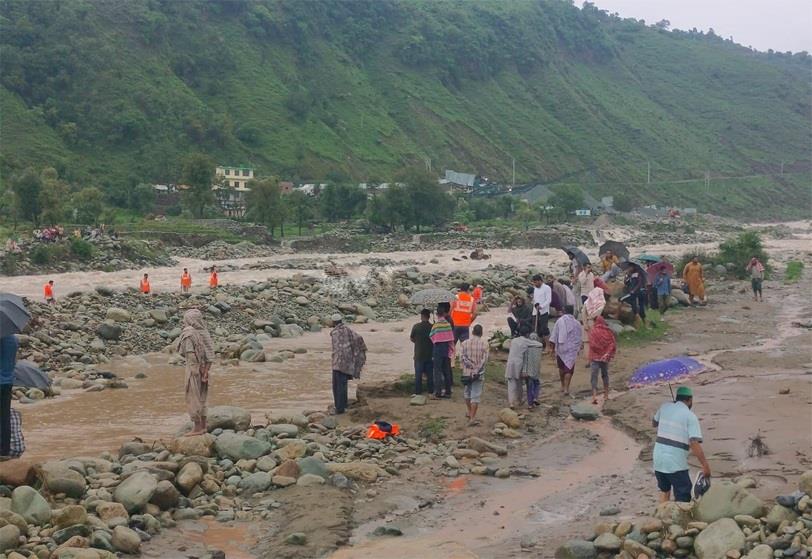
Climate Change Taking Toll On Kashmir's Fragile Ecosystem
File Photo
In The Month of July Alone, Kashmir Valley Witnessed Three Cloudbursts And A Dozen Flash Floods
Srinagar- Kashmir's fragile ecosystem seems to be bearing the brunt of rising temperatures and climate change, as at least three incidents of cloudbursts and a dozen flash-floods were witnessed in the month of July in the Valley, leaving as many as 15 people dead.
From the last two months, the incessant rainfall threatened flooding only for the temperature to start rising again. At the same time the humidity remained high.
Climate change has also manifested itself in unseasonal snowfall, heavy or scanty rainfall and hailstorms in recent years.
It may be noted that capital, Srinagar saw a major drop in the number of snow spells this winter season compared to the previous four years, with the experts terming it as a weathervane of coming prolonged warmer months compared to colder months, unlike the past weather pattern.
Dr. Majid Farooq, Scientist at J&K Climate Change Centre Department of Ecology, Environment and Remote Sensing, argues that the valley is the victim of rising global temperature and climate change.
“You need to understand that it is a global phenomenon, you have to understand its global perspective. The temperature is rising due to industries, the valley doesn't have many industries,” Majid said.
According to the data of the India Meteorological Department (IMD), November 2021 witnessed no major wet spell or snowfall in Srinagar compared to the five wet spells in 2020, 11 in 2019, four in 2018.
In the month of June and July, the heavy and moderate rainfall triggered a number of flash floods in many districts of the Valley including the city, besides causing damage to the agricultural fields, private property and also led to rivers brimming up.
On June 22, the ghost of 2014 devastative floods returned to haunt Kashmir after river Jhelum crossed the danger mark at different locations, following the four days of incessant rains.
Several low-lying areas of Srinagar and other parts of Kashmir were inundated after the water level in major rivers and tributaries rose sharply.
In many areas of Srinagar, people started shifting to second stories of their houses. However, the rains stopped after four days subsiding the flood threat.
A weather department official told Kashmir Observer that flash floods will occur in the Himalayan region during the monsoon time.
“…However, the monsoon rainfall is okay for plain areas but for hilly ones, it creates problems like flash-floods,” the official said.
He further added that the Valley witnessed at least a dozen flash-floods in the month of July only, while three cloud bursts were also reported.
He said that because of the peculiar topography, Kashmir will witness climate variability and hence cloudbursts, flash-floods etc.
On July 08, at least 15 Amarnath pilgrims died and over 55 were injured after a cloudburst hit the hills near the holy cave triggering flash floods.
Similarly, On July 27, a cloudburst hit Chakwali Nallah in Tulail area of Gurez in north Kashmir's Bandipora district which led to an overflow of a nearby stream.
However, Dr. Majid Farooq says that the cloudbursts used to happen in Kashmir earlier as well but now it is being reported more with the advent of technology.
Dr. Mohammad Muslim, Assistant Professor, Environmental science, Kashmir University argues that there has been drastic change in terms of land use in the watersheds of Jhelum basin ( Kashmir valley) rivers since last three decades.
“…as a result hydrologic response of the watersheds of Jhelum basin has changed,” Muslim said.
While explaining it further, Muslim said trees and the associate vegetation cover intercept the precipitation and improve hydrological conditions of watershed by enhancing retention of water.
“This phenomenon is critical in determining resident time of water. Thus significant change on land-use change soil hydrological conditions and is culprit behind the peak in discharge with extreme precipitation events in watersheds of Jhelum basin, Muslim added.
He further blamed“climatic extremity” for the flood threat and flash-floods in the valley.
“Earlier, there would be five days or ten days of rainfall but not now you witness five days of rainfall in one day. We call it an extreme event, which together with poor catchment conditions has made us more vulnerable,” he added.
It may be noted, that post 2014 devastating floods in the valley, devastating floods of 2014, the Government of India sanctioned the plan for comprehensive flood management of river Jhelum and its tributaries.
An amount of Rs 399 crore was sanctioned for the first phase which was completed recently. The government claimed that it will enhance the discharge carrying capacity from 31,800 cusecs to 41,000 cusecs.
However, even after completion of Phase I of the project, the flood threat still looms large.
“The flood channels and rivers have lost the carrying capacity, even the dredging is not helping out,” said Danish Farooq, a resident of Srinagar.
Earth scientist Shakil Romshoo, the Vice-Chancellor of the Islamic University of Science and Technology (IUST), however argues that the dredging should be an annual affair as the soil erosion has filled the major rivers and its tributaries in the valley and needs annual debilitation.
“Over 70% of the land in the valley is prone to soil erosion,” Ramshoo said.
He further argued that the valley has natural mechanisms for the dispersal of floodwaters.“The largest flood basin in Kashmir is Wular Lake, and besides the scores of the wetlands on the left and right side of the Jhelum,” Romshoo said.
Follow this link to join our WhatsApp group : Join Now

Legal Disclaimer:
MENAFN provides the
information “as is” without warranty of any kind. We do not accept
any responsibility or liability for the accuracy, content, images,
videos, licenses, completeness, legality, or reliability of the information
contained in this article. If you have any complaints or copyright
issues related to this article, kindly contact the provider above.


















Comments
No comment